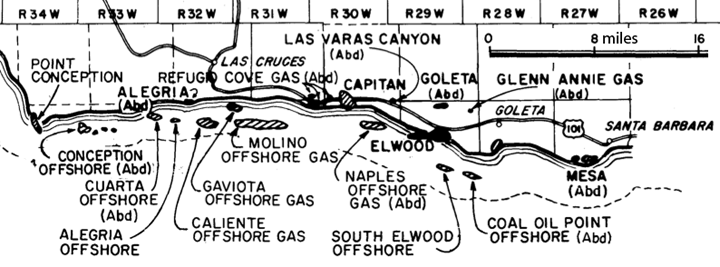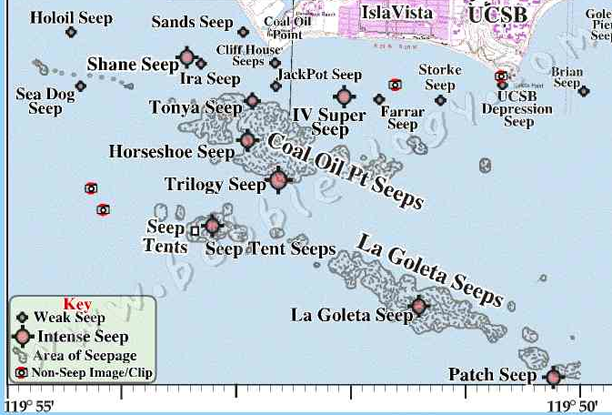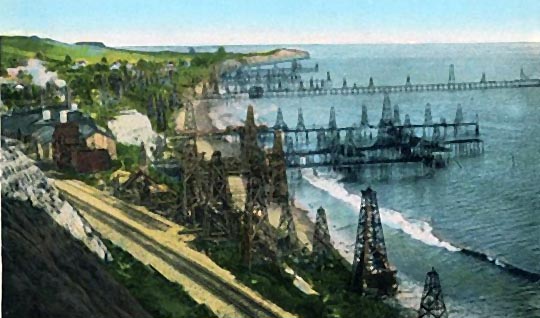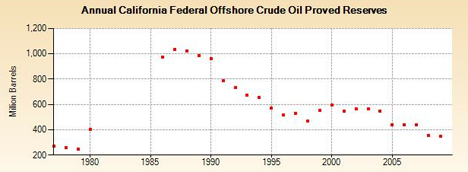Tech Talk - The Oil that Lies Offshore California
Posted by Heading Out on June 20, 2011 - 11:14am
Last week I covered some of the early history of the development of the oil industry in California, and briefly mentioned the difficulties in integrating an ongoing oil industry into a thriving surface community. I thought to take this ongoing debate offshore this week, since one of the remaining most productive regions in California (???*) is actually offshore. It is also where the “Drill, Baby, Drill” argument runs into fervent environmental opposition.

The events following the Deepwater Horizon oil disaster in the Gulf of Mexico last summer were probably the first times that most folk realized that there are not only seeps of oil on land which have been used to show where oil might be found, but that these also occur out in the Gulf and in the ocean. Part of the discussion last summer was about identifying some of the plumes of oil found in the Gulf, to ensure that they did come from the Macondo well, and not from the natural seeps that continue to flow to this day. These seeps are also found off the coast of California, with the most famous being those around Coal Oil Point just off Santa Barbara.

The presence of the seeps is detected onshore through the oil slicks that appear on the sea surface, and the tar balls that wash up on the beach. And without seeking to defend the oil industry, they were coming ashore before there was a well offshore CA, and will continue to come ashore long after the wells are abandoned. (Not that this will stop the protests). Natural gas can often also bubble out from these seeps, and with recent concerns over climate change, this is helping drive additional studies of them.
As oil exploration spread up through California from Los Angeles, it reached the town of Summerland and the early wells were drilled onshore. However, producers noticed that the wells nearest the coast were the more productive and so, in 1887 H.L. Williams ran a jetty out into the sea some 300 ft, and sank an oilwell from it. It came in as a producer and, as the postcard below shows, before long there were several such piers running out into the sea, with the longest being some 1,200 ft. Other companies tried to access the oil offshore through slanted drilling from onshore wells.

The first fully offshore drilling platform and well was carried out in the Gulf of Mexico in 1947, a region I will come back to later, but it provided the tool to help further develop the resources off-shore in California. The first offshore well in California was drilled in 1956. (Platform Hazel) (which seemed to attract fish ). It was removed in 1996). Unfortunately those early wells were plugged and abandoned as the oil ran out before current regulations were in place. And so there is some concern at present that the 400 wells that lie along the coast from Summerland to Santa Barbara may have started leaking – as there has been a recent increase in oil coming ashore.
. . . (the wells) were left for dead, with a wide variety of rather inadequate capping techniques such as using logs, trash, telephone poles, and rocks to block up the oil-spilling sea-floor sores.
Acknowledging this situation, the county’s head of the Office of Emergency Services, Michael Harris, told the supervisors “The wells were either just abandoned or capped inappropriately … really whatever they could do to stop the leaking was used.”
The ongoing questions as to where the oil is coming from (old wells or from natural seeps) is therefore a continuing concern along the Western Seaboard. But it was not the leakage from abandoned wells that has had the greatest impact on American oil production. That came on January 28, 1969 in the Santa Barbara channel, when the third worst oil spill in American history (after the Deepwater Horizon and Exxon Valdez spills) occurred on the Union Oil Alpha platform.
. . . pipe was being extracted from a 3,500 foot deep well. The pressure difference created by the extraction of the pipe was not sufficiently compensated for by the pumping of drilling mud back down the well, which caused a disastrous pressure increase.
As the pressure built up and started to strain the casing on the upper part of the well, an emergency attempt was made to cap it, but this action only succeeded in further increasing the pressure inside the well. The consequence was that under extreme pressure a burst of natural gas blew out all of the drilling mud, split the casing and caused cracks to form in the seafloor surrounding the well. A simple solution to the problem was now impossible; due to the immense pressure involved and the large volume of oil and natural gas being released a “blowout” occurred and the 1969 Santa Barbara oil spill was under way.
Around three million gallons of oil escaped before the injection of mud stopped the flow. Because the flow was so close to shore the oil reached nearby beaches along 35 miles of the coast, layering oil up to six inches thick onto them, and causing a catastrophe to local wildlife. Public outrage was immediate, and the Environmental Movement was given an immediate boost with the creation of the National Environmental Policy Act of 1969, and the formation of the Environmental Protection Agency (EPA) followed in 1970. Within California the Coastal Commission was formed, and the State Land Commission banned offshore drilling in coastal waters for 16 years. The first Earth Day was held that year.
However, further offshore (beyond 3 miles) the Federal Government has jurisdiction and the first Outer Continental Shelf (OCS) well had been drilled in federal waters in 1967 (Platform Hogan). By December 2009, that platform had produced 20.4 million barrels of oil and about 20.8 billion cu ft of natural gas, with 12 wells in production on the platform. In 2003, 23 of the 27 platforms offshore were in Federal waters and all supported multiple wells.
Drilling multiple wells from individual platforms is common in this region, and, among other things has the advantage of limiting the obvious visual impact of the rigs on the view. There is considerable concern over new drilling in coastal waters, and even drilling slant holes from existing wells to reach oil has been frowned on by the Lands Commission. There are moves in the US Congress to encourage more development off California, but it remains very controversial. Further the recent controversy over the impact from hydraulic fracturing of gas wells has now reached Santa Barbara and is raising concerns, even onshore.
It is difficult, at this time, to predict the future for this region – environmental pressure is great in restricting further development within the coastal areas under State control, and there are a number of known fields that lie within that limit. Beyond it lies the OCS where the pressure of rising prices might help encourage further drilling; sadly, emotion may have greater impact there than reality. At the same time, with all this potential activity, the reserves offshore are seen by the EIA to be falling. (H/t jjhman )

However, as JoulesBurn noted in commenting on my last post, 77% of Californian production now comes from Kern County, and so we’ll have to wander up to Bakersfield next before leaving California.




What, roughly, might be the net market value (that is subtracting production costs, etc.) of the remaining undrilled (known) California oil?
I ask because I think an interesting, if desperate, move that California could make is open up those areas for drilling, but have 100% of the profits go to a state-run fund that can only be used for non-oil based systems like high-speed rail, other regional rail, and solar thermal farms.
Not quite a response to your query, but shows that CA's production is declining slower than AK, but nevertheless the dependence on foreign sources looks to be growing faster than either. The total has been on a mildly declining plateau for decades, though, like so many other developed nations - CA is the world's de facto 8th largest economy. Real numbers available here: Oil Supply Sources To California Refineries.
CA's Energy Commission has a lot of useful data on their websites, no doubt including revenue info. One could extrapolate what "domestic" oil brought in in the past, and mull over what a state sponsored - "NOC"? - "SOC"? - could do in the way of replacing that lost production. Bringing about such a change sounds like an even bigger legal nightmare than BAU in the FF industry, though.
Thanks, interesting stuff - especially the mix.
Its also interesting to note that California used over 100,000 more barrels of oil in 1989 (712,603) than in 2010 (607,218)...
If the numbers on California oil consumption refer to barrels of oil per year, then I think that the actual quantities would have to be 712 million barrels vs 607 million barrels per year (712,603,000 vs 607,218,000). The percentage change would be the same, and the point is well taken. But unless I'm mistaken, the absolute quantity of the difference is greater X 1000. Therefore, the decrease in annual usage (1989 to 2010) is by ~100 million barrels and not by only 100,000 barrels.
Good point! My bad...thanks for clarifying...
California used over 100,000 more barrels of oil in 1989 (712,603) than in 2010 (607,218)...
I don't know what that means or where you got it. However, crude oil numbers aren't necessarily that meaningful. California outsources much of its refining to other states, Canada, and other countries because it's very difficult to operate an oil refinery in California.
The numbers I have from the EIA show that in 1989, PADD 5 (West Coast) used 2,636,000 barrels per day of refined petroleum products. California would have accounted for most of the West Coast consumption. In 2010, it was 2,827,000 b/d.
However, it peaked in 2005 at 3,092,000 b/d before the roof caved in.
I got the information from this link which was included in the article above:
http://energyalmanac.ca.gov/petroleum/statistics/crude_oil_receipts.html
In addition to getting the numbers wrong by reporting 1000s instead of millions...it would appear that you are correct and the number only refers to oil supplied to refineries...not consumption.
All in all, it seems to be a very weak attempt on my part at interpreting data...
Oh well, there always tomorrow :)
On your outsourcing comment:
As of 2010 EIA reports that California has 11.7% of U.S. refinery capacity, but uses only 9.6% of total refined products. That would be because NV, AZ, and OR outsource their refining to CA (well, and TX in the case of AZ, and WA in the case of OR).
According to EIA, US crude oil imports dropped about 8.6% from 2007 to 2010. But it looks like foreign oil imports to California were unchanged.
http://www.eia.gov/dnav/pet/pet_move_impcus_a2_nus_epc0_im0_mbbl_a.htm
I'd guess that's because PADD V isn't a direct beneficiary of increased domestic production in TX or ND or GOM OCS, and demand isn't being destroyed fast enough to cause imports to decline significantly.
This first is owing to the lack of a east-west crude line. I do see some lines running through AZ and NM on this big jpeg map, and I see there's a refinery in Artesia, NM, that obtains crude from the Permian Basin and Cushing; and this supplies markets which also are fed by refineries in CA, so in theory California can be gradually taken off the hook for providing product to these intermountain states; but it doesn't look to be turning out that way.
Will you be doing any pieces on Alaska, HO? I've been reading up on TAPS and the North Slope, estimates of the MOL for the line seem to be all over the map. Yet almost all estimates for its going out of commission are around the BAU dates for world peak - 2030, 2040, like that. Yet! You extrapolate the 2009/2010 YOY decline just a few years, and get things down to a dribble very quickly. At the least all the problems with wax/ice/etc brought on by low flow volumes will make things much less profitable quite soon.
KLR - What legal problems do you envision? You don't mean with the state actually doing the drilling, do you? Any state, or the feds, have the right to drill their minerals anytime they want but I think you already know that. The state can put any royalty they want on new leases also. If CA wants a 90% royalty then all they have to do is say so. Of course, that might kill virtually all new drilling projects by the industry. But the state could always risk their own money drilling and pocket all the profits for themselves. And pay for all the loses too.
I think I must be missing something about your statement.
Aside from the emotional offshore issue, California is inflicted with a constitution that makes it virtually impossible to impose even a one percent royalty. So there is (almost) no incentive for the state to open up these areas. Obviously the rational thing to do would be to offer these areas with high (not 90%) royalties. Compared to the present situation opening them up with say 40% royalties would be win win.
EOS - Amazing...no royalty structure? Can't imagine the logic behind that other than to kill the state's incentive to lease it's lands.
That's exactly the reason. A lot of money (non oil) is the reason
I think its partly historical. As an early oil boomstate the oil companies got to write the rules early on. Then we have the foolish prop 13, which means no tax of any kind which means it takes a 2/3rds majority to raise any sort of tax whatsoever. They tried a proposition to raise a six percent royalty a few years back, but the sheeple are easily fooled "it will make your gas(oiline) more expensive", backed by hundreds of million in advertising got that defeated.
"California is inflicted with a constitution that makes it virtually impossible to impose even a one percent royalty."
Wow, truly Amazing ...
(almost as much as the current gas tax level in the US)
FOR ALL: there seems to be some confusion. “The 1957 wildcat royalty was increased to a sliding scale, slightly different than the sliding scale used for proven leases. Under the wildcat sliding scale, California retained 1/6, or 16.7% of the oil if 100 bpd or less were produced, 28.6% if 200 bpd were produced, 37.6% if 300 bpd were produced, and 50% if 500 bpd or more were produced. “
http://hep.ucsb.edu/clearview/calitide.html
It appears CA has the highest royalty structure by far of any state in the country. But it doesn’t make much difference: the state has not offered one acre of mineral lease since 1968. It would seem any internal debate on royalty is pointless, be it 1% or 99%, if they aren’t leasing any of the state lands.
ROCKMAN, thanks a lot for the correction/information
In addition to being a major oil producing state (3rd largest) that doesn't lease any of its own land for drilling, California is also unusual in that it doesn't levy a state severance tax on oil production.
Most oil-producing states levy such a tax, in Texas it is 4.6% on oil produced in the state and pulls in over $2 billion/year, in Louisiana it is 12.5% but the take is under $1 billion. An oil severance tax was proposed for California in 2006 but was shot down. If it had been approved at 6%, it would currently be pulling in over $1 billion per year.
Rocky - I caught that fact also in my research. Truly odd that a state that seems to have a negative attitude towards the oil patch: why would they let them slide by like that. Texas S/T seems fair to me. La. OTOH is rather severe but we keep drilling there. Even counties in Texas collect a small (1-3%) ad velorum tax. Imagine how happy L.A. county would be with that extra revenue coming in.
And no...we don't raise the price of oil/NG to make up for those taxes: we gouge every penny we can get away with whether there's big taxes or not. `
It appears that California is letting a lot of potential revenue slip through its fingers. No wonder it has the lowest credit rating of any state in the US.
Los Angeles is sitting on some pretty big oil fields, which as you note, it would be able to tax if it was in Texas.
Just a few days ago I was going through some old records and came across a memo regarding an inquiry I had made in 2003 about the property tax assessment on the three platforms within Huntington Beach's jurisdiction. Turned out, they were extraordinarily low in comparison to Los Angeles and Santa Barbara Countys' platforms. The city's tax consultant was not able to uncover the rationale and the city has no status to challenge the assessment. If anyone knows anything about how platforms should be assessed, I would love to hear more.
Are these property tax assessments what we would call "rentals" in the international business?
For example, $2/ acre for non-producing "exploration" lands, and $50/ acre for "developed" or producing lands?
Why don't you find out how much is charged in the UK North Sea or the US GOM, or Canadian East Coast Offshore in Federal waters (e.g. Sable Island, Hibernia, Panuke)? They would be the best and most readily available analogies.
Debbie - I suspect we need to know how the assessment is calculated. Two indentical platforms half a mile apart can have a huge difference in value. One might be producing $50 million of production a year and the other $2 million/yr. Thus if the assessment is based upon a revenue stream there should be a wide gap. And if the assessment is based strickly upon the absolute value of that steel structure sitting in the water the assessment should be equal. And it should be $zero. A nonproducing platform is not an asset as a rule. It is a liability. The last big platform removal I dealt with 15 years ago was going to cost us $20 million to decommission. Fortunately we found a short cut: only cost $6 million.
There was a post in a previous Drumbeat that referenced one of six future trends(?): "The economic value of the environment over and above its potential as a resource." I was in SoCal at the time of the Santa Barbara. They got it right with the offshore ban. The California coast, unpolluted has been worth vastly more in tourism, etc. than any extraction of oil could have produced. There is an economic value of the aesthetic. This article seems to imply California, by being the avante garde of "green" somehow missed some great economic opportunity. Have you ever been along the California coast? On foot, in a car, on a horse? Priceless.
Hi HO,
Thanks for this article.
It turns out, there is some onshore NG drilling currently being proposed for the little area (approx. "R27W") of your top map, between UCSB and Mesa (as noted on map).
If it would not detract from the discussion, I'd be very interested in feedback from TODers about
the following:
1. If one was concerned for the well being of the residents of this area, putting aside the question of their having NG to use - ("Hypocrisy lies waiting for us all.") - are there any particular concerns that might strike you all, based on the following proposal?
http://www.countyofsb.org/energy/projects/SoCalGasStorage.asp
“Project Description
Proposal by Southern California Gas Company to produce native gas from an onshore natural gas reserve located under their La Goleta Storage Field. The project would include the development of 2 production wells, 2 exploratory wells, 2,800 feet of underground pipeline, and a dehydration unit at the La Goleta Storage Field. The applicant estimates there is 3 to 5 billion cubic feet of recoverable gas. The withdrawal of native gas would enhance the existing storage field by expanding the total storage capacity at the facility. Once gas reserves have been produced, the production wells would be integrated into storage operations. The exploration wells are proposed to investigate the feasibility of producing native gas from an adjacent natural gas reserve.”
2. I'd welcome constructive feedback, such as additional concerns that it may be beneficial to address ahead of time, etc.
Here is an excerpt from a letter sent to the neighbors by a concerned resident:
"The environmental concerns that they addressed last night were visual (the 130’ high crane), traffic (up to 160 truck trips a day on Patterson and More Ranch Road; maneuvering around the curves of More Ranch Road), air quality (dust and other air pollution), hazardous materials (including the slight risk of explosion), and noise.
My personal concern is noise. One year ago I was driven batty by the high-pitched whine that began every afternoon and lasted into the evening. This went on for many months. The Gas Company declined hearing anything of the sort, but they managed to quiet that piece of machinery that made the noise. When the whine began again this spring, I immediately complained to city and county officials, and to the Gas Company. The noise stopped and two representatives came to my house to assure me that they wanted to be good neighbors. These days I sometimes hear the squeal around noon or around 6:00 pm, but it stops within 5 minutes.
Noise from the expansion of the gas drilling and storage will include truck and construction noise (7:00 am to 7:00 pm), drilling sounds (24/7), and vibrations “below human thresholds.” The company assures that the drilling noise can be mitigated by noise barriers and noise blankets. It is estimated that the daytime noise will be at 65 decibels, measured at the nearest residence, and the nighttime noise will be at 50 decibels. The warning horns that go off periodically might increase in number later with the added storage and the processing of the extra natural gas."
This may be hard to believe but Leigh Price, the USGS scientist who defined the Bakken's potential before he died, told me back in the 70's that the Point Conception region of California (off shore) contained an estimated 27 billion bbls of oil. Now this,I believe was the total oil in place but it is as astonishing number.
As A 21 proved the geology of the region is all broken up and rotten for drilling. The seeps attest to this in part. None the less that is a lot of oil and drilling has improved in quality and technique.
What will ther Calofornians do? They need the money that's for sure. Just ask Gerry Brown who still gets a stipend or royalty from his Dad's oil trading in Asia.